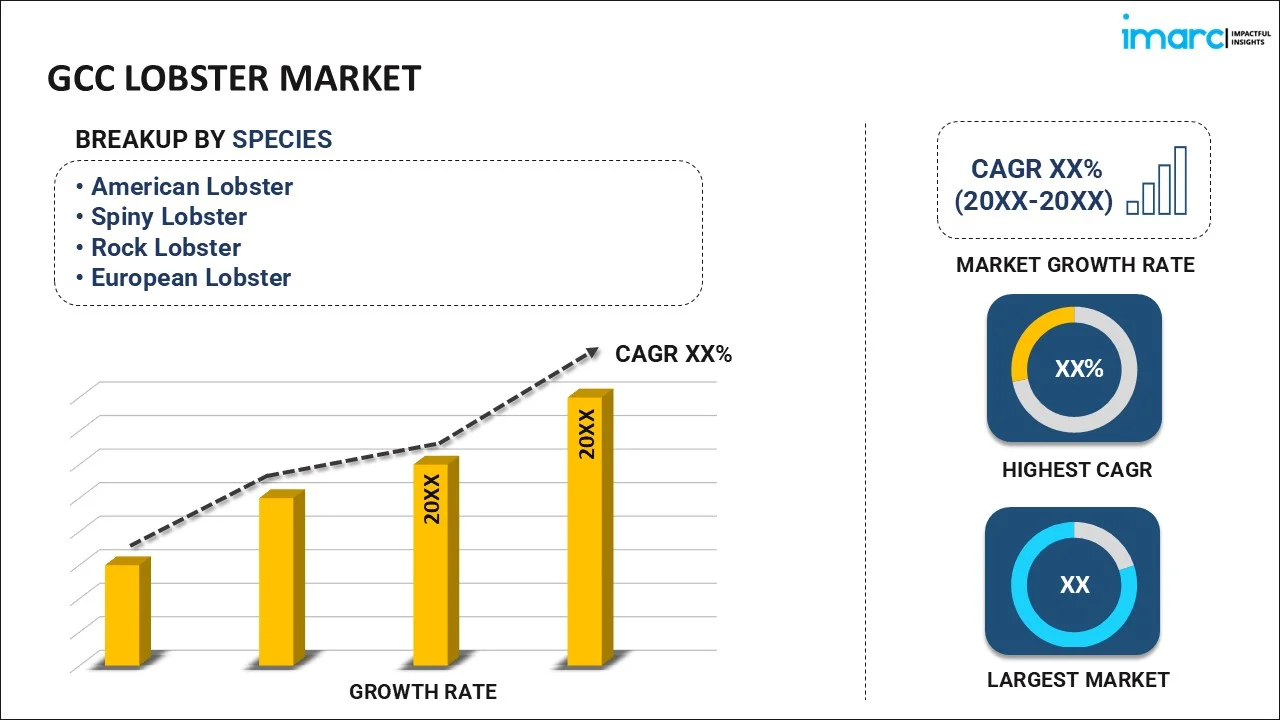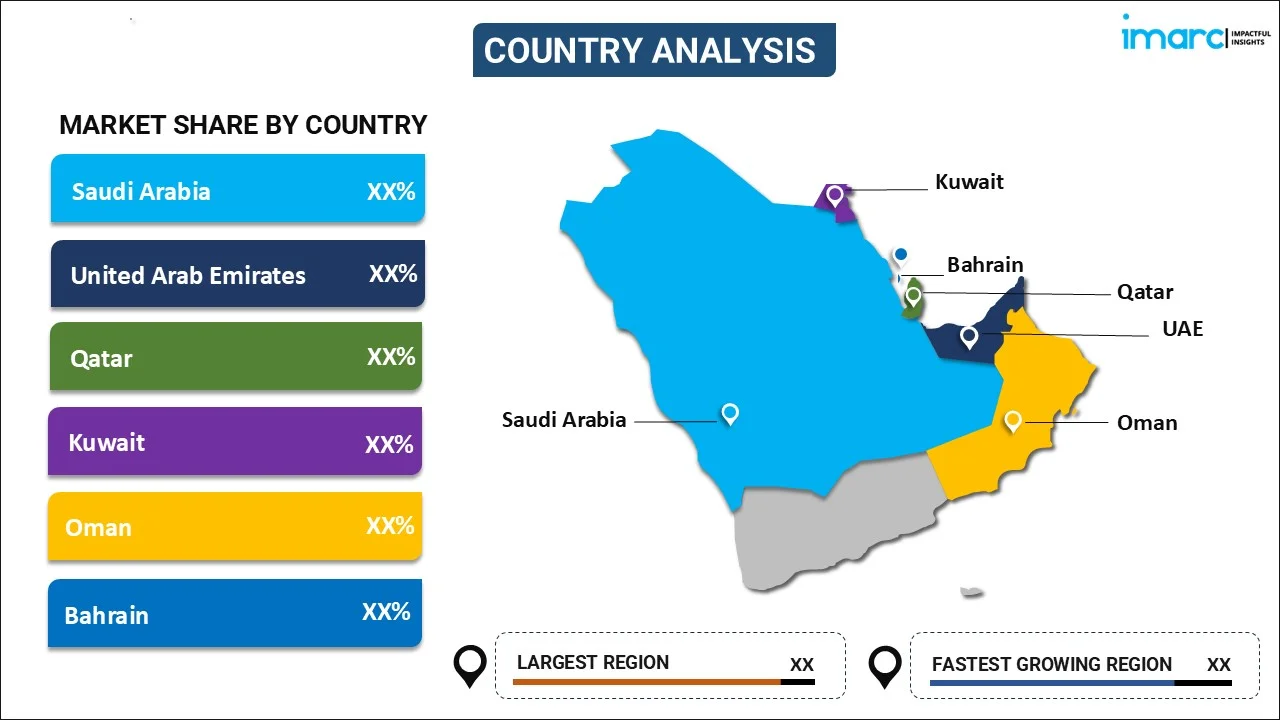
GCC Lobster Market Report by Species (American Lobster, Spiny Lobster, Rock Lobster, European Lobster), Weight (0.5 – 0.75 lbs., 0.76 – 3.0 lbs., Over 3 lbs.), Product Type (Whole Lobster, Lobster Tail, Lobster Meat, Lobster Claw), Distribution Channel (Food Service, Retail), and Country 2025-2033
Market Overview:
The GCC lobster market size reached USD 159.1 Million in 2024. Looking forward, IMARC Group expects the market to reach USD 214.2 Million by 2033, exhibiting a growth rate (CAGR) of 3.4% during 2025-2033. The expanding economic growth, rapid urbanization, the burgeoning tourism and hospitality sector, the escalating health consciousness among consumers, and the bolstering retail infrastructure represent some of the key factors driving the market.
|
Report Attribute
|
Key Statistics
|
|---|---|
|
Base Year
|
2024
|
|
Forecast Years
|
2025-2033
|
|
Historical Years
|
2019-2024
|
|
Market Size in 2024
|
USD 159.1 Million |
|
Market Forecast in 2033
|
USD 214.2 Million |
| Market Growth Rate 2025-2033 | 3.4% |
A lobster is a type of marine crustacean distinguished by its large size, long body, and strong, clawed forelimbs. Belonging to the family Nephropidae, lobsters are typically found in all oceans worldwide. It is a high-value seafood commodity renowned for its rich, succulent taste and high nutritional content. Lobster is a versatile product, and it can be prepared using various cooking methods, including boiling, grilling, steaming, and baking. The meat, primarily found in the tail and claws, is characterized by a sweet, tender, and slightly salty flavor, often considered a delicacy in many cultures. It has rich content of high-quality protein and several important vitamins and minerals, such as vitamin B12, zinc, selenium, and omega-3 fatty acids. Lobsters are marketed in various forms, such as live, frozen, or processed into products, including lobster tail, lobster meat, lobster bisque, and others. Frozen lobster-based products offer convenience and longer shelf-life, appealing to retailers and consumers who value these aspects.
GCC Lobster Market Trends:
The GGC lobster market is driven by significant economic progress across the region and a rise in personal disposable income, making indulging in luxury items more accessible. Concurrent with this, with the flourishing growth of the tourism sector, there is rising demand for local and international cuisines that includes premium seafood options such as lobster. Moreover, the region's rich cultural heritage manifests itself in grand celebrations and gatherings, where luxurious culinary dishes are increasingly in demand. In line with this, the expanding consumer exposure to different cuisines, including lobster dishes, is further increasing local demand. In addition to this, the escalating health-conscious among the population about the numerous health benefits of their high protein and low-fat content is creating a favorable outlook for market expansion. Furthermore, the robust trade relations of GGC nations with major lobster exporting countries such as Canada and the U.S., facilitating the import of high-quality lobsters into the region, is contributing to the market growth. Other factors, such as rapid urbanization, the expanding influence of global gourmet trends and Western culinary, and the burgeoning growth of the hospitality industry, including hotels and catering services, are positively impacting the market growth.
GCC Lobster Market Segmentation:
IMARC Group provides an analysis of the key trends in each segment of the GCC lobster market report, along with forecasts at the regional and country levels for 2025-2033. Our report has categorized the market based on species, weight, product type, and distribution channel.
Species Insights:

- American Lobster
- Spiny Lobster
- Rock Lobster
- European Lobster
The report has provided a detailed breakup and analysis of the market based on the species. This includes American, spiny, rock, and European lobsters. According to the report, American lobster represented the largest segment.
Weight Insights:
- 0.5 – 0.75 lbs.
- 0.76 – 3.0 lbs.
- Over 3 lbs.
A detailed breakup and analysis of the market based on the weight has also been provided in the report. This includes 0.5 – 0.75 lbs., 0.76 – 3.0 lbs., and over 3 lbs. According to the report, 0.5 – 0.75 lbs. accounted for the largest market share.
Product Type Insights:
- Whole Lobster
- Lobster Tail
- Lobster Meat
- Lobster Claw
The report has provided a detailed breakup and analysis of the market based on the product type. This includes whole lobster, lobster tail, lobster meat, and lobster claw. According to the report, whole lobster represented the largest segment.
Distribution Channel Insights:
- Food Service
- Retail
A detailed breakup and analysis of the market based on the distribution channel has also been provided in the report. This includes food service and retail. According to the report, food service accounted for the largest market share.
Country Insights:

- Saudi Arabia
- UAE
- Qatar
- Bahrain
- Kuwait
- Oman
The report has also provided a comprehensive analysis of all the major regional markets, which include Saudi Arabia, UAE, Qatar, Bahrain, Kuwait, and Oman. According to the report, UAE was the largest market for lobsters in the GCC.
Competitive Landscape:
The report has also provided a comprehensive analysis of the competitive landscape in the GCC lobster market. Competitive analysis such as market structure, key player positioning, top winning strategies, competitive dashboard, and company evaluation quadrant has been covered in the report. Also, detailed profiles of all major companies have been provided.
Report Coverage:
| Report Features | Details |
|---|---|
| Base Year of the Analysis | 2024 |
| Historical Period | 2019-2024 |
| Forecast Period | 2025-2033 |
| Units | Million USD |
| Scope of the Report | Exploration of Historical and Forecast Trends, Industry Catalysts and Challenges, Segment-Wise Historical and Predictive Market Assessment:
|
| Species Covered | American Lobster, Spiny Lobster, Rock Lobster, European Lobster |
| Weights Covered | 0.5 – 0.75 lbs., 0.76 – 3.0 lbs., Over 3 lbs. |
| Product Types Covered | Whole Lobster, Lobster Tail, Lobster Meat, Lobster Claw |
| Distribution Channels Covered | Food Service, Retail |
| Countries Covered | Saudi Arabia, UAE, Qatar, Bahrain, Kuwait, Oman |
| Customization Scope | 10% Free Customization |
| Post-Sale Analyst Support | 10-12 Weeks |
| Delivery Format | PDF and Excel through Email (We can also provide the editable version of the report in PPT/Word format on special request) |
Key Questions Answered in This Report:
- How has the GCC lobster market performed so far and how will it perform in the coming years?
- What has been the impact of COVID-19 on the GCC lobster market?
- What is the breakup of the GCC lobster market on the basis of species?
- What is the breakup of the GCC lobster market on the basis of weight?
- What is the breakup of the GCC lobster market on the basis of product type?
- What is the breakup of the GCC lobster market on the basis of distribution channel?
- What are the various stages in the value chain of the GCC lobster market?
- What are the key driving factors and challenges in the GCC lobster market?
- What is the structure of the GCC lobster market and who are the key players?
- What is the degree of competition in the GCC lobster market?
Key Benefits for Stakeholders:
- IMARC’s report offers a comprehensive quantitative analysis of various market segments, historical and current market trends, market forecasts, and dynamics of the GCC lobster market from 2019-2033.
- The research study provides the latest information on the market drivers, challenges, and opportunities in the GCC lobster market.
- Porter's five forces analysis assist stakeholders in assessing the impact of new entrants, competitive rivalry, supplier power, buyer power, and the threat of substitution. It helps stakeholders to analyze the level of competition within the GCC lobster industry and its attractiveness.
- Competitive landscape allows stakeholders to understand their competitive environment and provides an insight into the current positions of key players in the market.
Need more help?
- Speak to our experienced analysts for insights on the current market scenarios.
- Include additional segments and countries to customize the report as per your requirement.
- Gain an unparalleled competitive advantage in your domain by understanding how to utilize the report and positively impacting your operations and revenue.
- For further assistance, please connect with our analysts.
 Inquire Before Buying
Inquire Before Buying
 Speak to an Analyst
Speak to an Analyst
 Request Brochure
Request Brochure
 Request Customization
Request Customization




.webp)




.webp)












